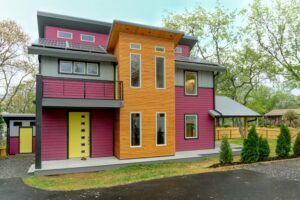In 1998’s “Armageddon” film, an asteroid was hurtling toward Earth at 22,000 mph and NASA sent Harry Stamper (aka Bruce Willis) to blow it apart with an H-bomb. If only climate change was so easy.

Instead, every second, 7.76 x 1035 photons from space (sun as a blackbody at T=6000K and solar constant 1361W/m2) are hurtling toward Earth at 671 million mph. Most of them pass right through Earth’s atmosphere to strike her surface. Earth battles back by reflecting 30 percent of them—this is why Earth is a beautiful blue ball.
The remainder of the photons from space are absorbed and their energy bounces around on the surface, in the ocean, and in the atmosphere until Earth returns fire—a volley of photons of power equal to that which it received.
The total energy of all the photons fired back by Earth must match the energy of the photons that strike it. If Earth fails to give back as good as it gets, then the photons from space win and Earth heats up.
The situation is scary; we are scared.
For 500 million years, plants have handled this battle by taking carbon dioxide out of the atmosphere, stripping off the oxygen and burying the carbon underground so carbon dioxide won’t block the photons that Earth fires back.
Our green friends have done a great job, particularly for Asheville, Earth’s best climate.
What is “green”? To us, green means supporting plants in their eons-long fight to keep carbon dioxide out of the air by burying carbon.
Americans burn buried carbon at an incredible rate, putting carbon dioxide back in the air. Buried carbon provides most of the energy for production and transportation, as well as to heat, cool, and light our homes. The average American puts about 90 pounds of carbon dioxide into the air every day.
Green Built Alliance supports a spectrum of goals for the “built environment”; they are all wonderful goals. Do they define green?
For some, green refers to an architectural style or a color palate.
For us, green means always focusing on the approaching asteroid—that is, climate change.
We focus on innovation. We strive to build the best homes on the planet that are also the best homes for the planet by discovering cost-effective techniques that advance building science. Our approaches must be economically viable; only in this way can they spread to have a broad positive impact.
We are developing and using new building techniques. Our homes incorporate materials that generate less carbon dioxide during manufacture; they sequester carbon; and they use very little energy.
Our homes generate less carbon dioxide because we avoid the use of concrete. Five to 10 percent of global manmade carbon comes from the manufacturing of concrete. By not using concrete, we avoid putting about two tons of carbon dioxide into the air for each house. We build our foundations with foundation-grade treated wood that is supported, kept dry, and held in place by massive amounts of gravel.
Can it be good to cut down trees? Trees use the carbon dioxide they take out of the air, and turn the carbon portion into wood. Wood is basically solidified carbon held together by a sprinkling of hydrogen. If trees die and rot, or burn, then the carbon simply returns back into the air as carbon dioxide. Milled trees can be great carbon dioxide combatants! They capture the carbon as lumber and we store it long term in houses so it does not add carbon dioxide to the air. Trees are regrown and the process begins anew. We take special care not to waste wood and we sequester as much carbon, i.e. wood, as possible; for example, by using our scraps to build a “carbon wall.”
Our homes use very little energy from burned carbon. Over the next few decades, electricity from the grid will come mainly from burning buried carbon. For now, we must maximize solar-photovoltaic rooftop capacity and minimize electric use.
Existing homes have the greatest potential for energy savings and present the greatest challenges. Often it is not viable to transform an existing home into a completely green home. For these circumstances, we invented a solution we call an “environmental safe room.” The very efficient “safe room” is a family’s refuge for harsh economic, weather, or utility-supply situations—particularly when paired with solar battery backup that supplies key circuits only.
The asteroid of climate change is coming; the building industry needs to innovate now to avoid Armageddon.
Big impact steps to save big energy
- Extreme sealing (0.5ACH at 50PA): Our unique approach places a continuous polyethylene sheet in a protected space between two exterior stud walls. This layer is essentially free of penetrations. In the early stages of framing, we do not cut window openings in the poly so we can use blower door equipment to check for perfect air sealing. As we install windows and doors, we periodically recheck for air tightness.
- LEDs are awesome!
Don Nicholson’s career went from carpentry to physics, attaining his doctorate in that field in 1982. He did materials research at Oak Ridge National Lab in Tennessee until 2014, when he teamed up with his son Donald, a professional poker player, to form their green-building company, Nicholson and Sun. Don and wife, Christina, live near UNC Asheville where he is a physics research professor. A member of the Tennessee Bar Association, Donald studied economics at Sewanee and received his juris doctor degree from the University of Memphis. Donald, Krystal, and their daughter, Maple, live in Asheville.
You can also view this article as it was originally published on page 26 of the 2017-18 edition of the directory.


